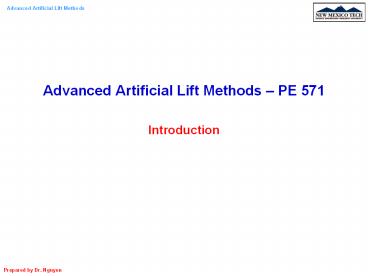Advanced Artificial Lift Methods - PowerPoint PPT Presentation
1 / 34
Title:
Advanced Artificial Lift Methods
Description:
Advanced Artificial Lift Methods PE 571 Introduction * * * Review Stability Casing Heading Advanced Artificial Lift Methods Prepared by Dr. Nguyen ... – PowerPoint PPT presentation
Number of Views:280
Avg rating:3.0/5.0
Title: Advanced Artificial Lift Methods
1
- Advanced Artificial Lift Methods PE 571
- Introduction
2
Review
Pressure Drop in a Production System
3
Review
Single Phase Liquid IPR and OPR
4
Review
Single Phase Liquid IPR and OPR
- The flowrate value at which a specific well flows
for a set of operational conditions using only
the energy stored in the compressed reservoir
fluids is called natural equilibrium flowrate
5
Review
Single Phase Liquid IPR and OPR
6
Review
Single Phase Liquid IPR and OPR
7
Review
Single Phase Liquid IPR and OPR
8
Review
Single Phase Liquid IPR and OPR
9
Review
Darcys Law - IPR
10
Review
Darcys Law - IPR
11
Review
IPR Vogel and Fetkovich
12
Review
IPR Vogel and Fetkovich
13
Review
Future IPR
14
Review
OPR
15
Review
OPR
16
Review
OPR
17
Review
IPR vs. OPR
18
Review
Stability
- Stable equilibrium small disturbance around the
equilibrium point, the system will move back to
the equilibrium condition. - Unstable equilibrium If the disturbance is large
enough, the system will move towards another
equilibrium point or loose the equilibrium
permanently
19
Review
Stability
- Fluctuations on the Pwh, qsystem lt qsteady state
20
Review
Stability
21
Review
Stability
22
Review
Stability
23
Review
Stability
24
Review
Stability
25
Review
Stability
26
Review
Stability
27
Review
Stability
28
Review
Stability
- Several techniques might be used when the system
reaches to the unstable point such as - If the well has an artificial lift installed
it can be put into production to help the well
overcome the unstable point. After that if the
artificial lift is not required we can leave the
well under natural flow. - If the well does not have an artificial lift
installed, we can do several things Agitation,
swab, gas injection, nitrogen injection
29
Review
Stability Tubing Heading
- High reservoir pressure
- Small PI
- Big tubing string
30
Review
Stability Tubing Heading
31
Review
Stability Tubing Heading
If the fluctuations are small then the well will
produce a steady state flowrate. If the
fluctuations are large, the production in this
well will cycle with time. This is called the
tubing heading. Tubing heading is characterized
by pulsating well head pressure (EX caused by
slug flow) and constant casing pressure. It
occurs mostly in wells fitted with a packer
during the final stage of life. During this
period, liquid is lifted through a portion of the
tubing and then falls back resulting a cycle
flow. Under these conditions, the production
test data from this well are very difficult to
match the IPR and OPR simulations.
32
Review
Stability Tubing Heading
- Very high PI
- Big tubing string
33
Review
Stability
34
Review
Stability Casing Heading

















![Investigations on Automatic Behavior-based System Design [A Survey on] Hierarchical Reinforcement Learning PowerPoint PPT Presentation](https://s3.amazonaws.com/images.powershow.com/6219810.th0.jpg?_=20150306026)













